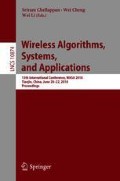Abstract
Placing relay nodes in wireless sensor networks is a widely-used approach to construct connected network topology. Previous works mainly focus on the relay node minimization while achieving network connectivity but pay less attention on the path performance guarantee. In this paper we first investigate the hop-constrained relay node placement optimization which aims at using as few relays as possible to construct sensor-to-sink paths meeting the hop constraint given by the end user. We present a heuristic-based algorithm to solve the above optimization problem and evaluate its performance by extensive simulation. The experimental results demonstrate that the efficiency of our designs in comparison with two baselines.
W. Chen—This work was supported, in part, by the National Natural Science Foundations of China with Grants No. 11671400 and No. 61672524, the Fundamental Research Funds for the Central University, and the Research Funds of Renmin University of China with Grant No. 18XNH109.
Access this chapter
Tax calculation will be finalised at checkout
Purchases are for personal use only
References
Younis, M., Akkaya, K.: Strategies and techniques for node placement in wireless sensor networks: a survey. Ad Hoc Netw. 6(4), 621–655 (2008)
Manshahia, M.S.: Wireless sensor networks: a survey. Int. J. Sci. Eng. Res. 7(4), 710–716 (2016)
Akyildiz, I.F., Su, W., Sankarasubramaniam, Y., Cayirci, E.: A survey on sensor networks. IEEE Commun. Mag. 40(8), 102–114 (2002)
Potdar, V., Sharif, A., Chang, E.: Wireless sensor networks: a survey. International Conference on Advanced Information NETWORKING and Applications Workshops, pp. 636–641 (2009)
Ding, X., Sun, G., Yang, G., Shang, X.: Link investigation of IEEE 802.15.4 wireless sensor networks in forests. Sensors 16(7), 987 (2016)
Cheng, X., Du, D.Z., Wang, L., Xu, B.: Relay sensor placement in wireless sensor networks. Wireless Netw. 14(3), 347–355 (2008)
Lee, S., Younis, M.: Optimized relay node placement for connecting disjoint wireless sensor networks. Comput. Netw. 56(12), 2788–2804 (2012)
Xu, X., Liang, W.: Placing optimal number of sinks in sensor networks for network lifetime maximization. In: IEEE International Conference on Communications, pp. 1–6 (2011)
Ma, C., Liang, W., Zheng, M., Sharif, H.: A connectivity-aware approximation algorithm for relay node placement in wireless sensor networks. IEEE Sens. J. 16(2), 515–528 (2015)
Bhuiyan, M.Z.A., Cao, J., Wang, G.: Deploying wireless sensor networks with fault tolerance for structural health monitoring. IEEE Trans. Comput. 64(2), 382–395 (2015)
Lee, S., Younis, M., Lee, M.: Connectivity restoration in a partitioned wireless sensor network with assured fault tolerance. Ad Hoc Netw. 24(PA), 1–19 (2015)
Abbasi, A.A., Younis, M.F., Baroudi, U.A.: Recovering from a node failure in wireless sensor-actor networks with minimal topology changes. IEEE Trans. Veh. Technol. 62(1), 256–271 (2013)
Ma, C., Wei, L., Meng, Z.: Delay constrained relay node placement in two-tiered wireless sensor networks: a set-covering-based algorithm. J. Netw. Comput. Appl. 93, 76–90 (2017)
Senel, F., Younis, M.: Novel relay node placement algorithms for establishing connected topologies. J. Netw. Comput. Appl. 70, 114–130 (2016)
Ma, C., Liang, W., Zheng, M.: Set covering-based approximation algorithm for delay constrained relay node placement in wireless sensor networks. Comput. Sci. 36(8), 1–5 (2015)
Ma, C., Wei, L., Meng, Z.: Delay constrained relay node placement in wireless sensor networks: a subtree-and-mergence-based approach. Mob. Netw. Appl. 1–13 (2017). https://link.springer.com/journal/11036/onlineFirst/page/8
Lin, G.H., Xue, G.: Steiner tree problem with minimum number of steiner points and bounded edge-length. Inf. Process. Lett. 69(2), 53–57 (1999)
Author information
Authors and Affiliations
Corresponding author
Editor information
Editors and Affiliations
Rights and permissions
Copyright information
© 2018 Springer International Publishing AG, part of Springer Nature
About this paper
Cite this paper
Ding, X., Sun, G., Li, D., Wang, Y., Chen, W. (2018). Hop-Constrained Relay Node Placement in Wireless Sensor Networks. In: Chellappan, S., Cheng, W., Li, W. (eds) Wireless Algorithms, Systems, and Applications. WASA 2018. Lecture Notes in Computer Science(), vol 10874. Springer, Cham. https://doi.org/10.1007/978-3-319-94268-1_7
Download citation
DOI: https://doi.org/10.1007/978-3-319-94268-1_7
Published:
Publisher Name: Springer, Cham
Print ISBN: 978-3-319-94267-4
Online ISBN: 978-3-319-94268-1
eBook Packages: Computer ScienceComputer Science (R0)

